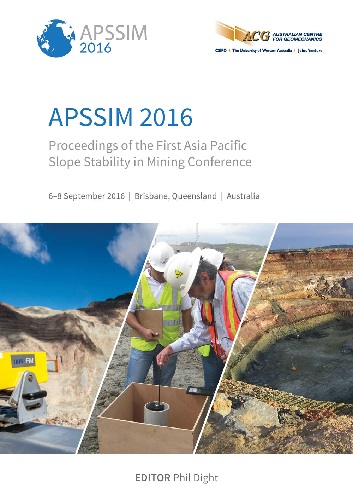A journey of wall control improvement at Boddington Gold

|
Authors: Graf, CC; Sullivan, R |
DOI https://doi.org/10.36487/ACG_rep/1604_25_Graf
Cite As:
Graf, CC & Sullivan, R 2016, 'A journey of wall control improvement at Boddington Gold', in PM Dight (ed.), APSSIM 2016: Proceedings of the First Asia Pacific Slope Stability in Mining Conference, Australian Centre for Geomechanics, Perth, pp. 407-420, https://doi.org/10.36487/ACG_rep/1604_25_Graf
Abstract:
Pit slope optimisation and the implementation of effective wall control techniques are a valuable aspect of the mining process. The objective of pit slope optimisation programs during mining operations is twofold; to develop safe operating conditions, and to minimise waste stripping ratios (O’Bryan 2013). By achieving these two aims, the pit slope angle can be maximised, and in turn can have a significant impact to the economics of an open pit operation. The Boddington gold-copper mine is owned and operated by Newmont Mining Corporation. Located approximately 130 km southeast of Perth in Western Australia, the Boddington operations commenced mining in 2007 with production from two large open pits utilising large-scale non-selective open pit mining methods. Situated within the Saddleback Greenstone Belt, the pits are being developed in a largely hard rock environment of good to very good rock mass quality. The pit slope configuration at Boddington has experienced a number of changes since the commencement of operations. Initial design recommendations indicated hard rock slopes could be constructed at an inter ramp angle of 64 degrees. This slope design is steep by industry standards. A challenge of the hard rock slopes at Boddington has been the inability to consistently achieve the required catch berm width to retain rockfall. This challenge has resulted in safety and economic value impacts including large areas of remedial work in operational areas, and step-ins to develop rockfall protection not provided by catch berms. As a result the inter-ramp angle was reduced to 59 degrees. To enable the consideration of steepening the inter-ramp angle above 59 degrees four key elements are required to be achieved; ongoing structural modelling and interpretation, consistent attainment of the designed wall configuration, blast designs achieving high quality batter conditions, and analysis showing proposed angles falling within stability acceptance criteria. Numerous trials have been completed, with the most significant in late 2013. This trial increased the batter height from 24 to 36 metres, and implemented crest scaling techniques and free faced trim blasts. Through the ongoing use and refinement of these techniques, and close collaboration between technical and operational teams, significant improvements have been made in reducing crest loss and improving batter conditions. Results have enabled wall steepening trials to be implemented in late 2015. This paper presents a case study of Boddington’s journey to create a repeatable wall control technique to enable the consistent attainment of the wall configuration, and achieve high quality batter conditions.
Keywords: crest loss, excavation control, slope performance
References:
Deere, DU, Hendron, AJ, Patton, FD & Cording, EJ 1967, ‘Design of surface and near surface construction in rock, in C Fairhurst (ed.), Proceedings of the Eighth US Symposium of Rock Mechanics, New York, pp. 237–302.
Lorig, L, Stacey, P & Read, J 2009, ‘Slope design methods’, in J Read & P Stacey (eds), Guidelines for Open Pit Slope Design, CRC Press/Balkema, The Netherlands.
O’Bryan, P 2013, ‘Wall failure and damage mechanisms’, in Blasting for Stable Slopes, Australian Centre for Geomechanics, Perth, Western Australia.
Ryan, TM & Pryor, PR 2000, ‘Designing Catch Benches and Interramp Slopes’, in WA Hustrulid, MK McCarter & DJ Van Zyl (eds), Slope Stability in Surface Mining, Littleton, Colorado, pp. 27–38.
© Copyright 2025, Australian Centre for Geomechanics (ACG), The University of Western Australia. All rights reserved.
View copyright/legal information
Please direct any queries or error reports to repository-acg@uwa.edu.au
View copyright/legal information
Please direct any queries or error reports to repository-acg@uwa.edu.au